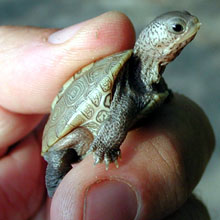Look out below, tiny turtles may be underfoot
A summer heat wave has terrapins along Cape Cod Bay coming out of their shells early.
By ROBIN LORD
STAFF WRITER
WELLFLEET - What
appear to be rolling stones in lowland and marshy areas of Cape Cod Bay may
actually be newly hatched terrapin turtles, saltwater reptiles that live
year-round in marshes.

 A heat wave has speeded up the hatching process for terrapin turtles along
Cape Cod Bay in Wellfleet. Wildlife experts say the turtles, which measure
about 1-inch and weigh a quarter-ounce, are in jeopardy of being trampled
by summer crowds.
A heat wave has speeded up the hatching process for terrapin turtles along
Cape Cod Bay in Wellfleet. Wildlife experts say the turtles, which measure
about 1-inch and weigh a quarter-ounce, are in jeopardy of being trampled
by summer crowds.
|
The extended heat spell this summer has speeded up
the hatching time of terrapin eggs, which are laid in upland areas such as
dunes, gardens, and even driveways.
Usually the first terrapin babies - which measure about 1 inch and weigh
about a quarter-ounce - emerge from their eggs after Labor Day, giving them
a fighting chance of making it unscathed to the marsh without being trampled
by summer crowds.
But, the first hatchlings showed up last Sunday, eight days earlier than
last year and 19 days earlier than in 2000, according to Cape Cod terrapin
expert Don Lewis of Wellfleet.
Lewis has been catching, counting and coddling the sea turtles ever since
he knocked on the door of the Massachusetts Audubon Society's Wellfleet Bay
Wildlife Sanctuary, after retiring seven years ago, and asked how he could
help.
With about 10 days left in the official summer season, the turtles will
have more people and vehicles than usual to dodge on their way from nests
to the marsh.
Threatened species Lewis now leads the
sanctuary's terrapin project, which aims to give the turtles a leg up in
their efforts to move off the state's endangered species list. They are considered
threatened.
Lewis starts out daily from his Wellfleet home to monitor the terrapin world.
During the winter, he watches for sick or injured animals. In the spring
and early summer, he watches where females make their nests. This time of
year, he's alert for hatching eggs and baby terrapins bolting toward the
marsh.
Lewis said he and his nearly 100 volunteers are not so much looking to stop
the inevitable harshness of nature - eggs and babies are tasty dinners for
many predators - but rather to "put a thumb on the scale.
"We're trying to compensate for the negative impact we humans are having because of our development in their marsh," he said.
|
|
Ways to help
 Keep your eyes open - and down - when moving in areas around salt marshes Keep your eyes open - and down - when moving in areas around salt marshes
 If you spot a baby terrapin, pick it up and carry it to the edge of the marsh If you spot a baby terrapin, pick it up and carry it to the edge of the marsh
 Never take a terrapin home . They are wild animals with special needs Never take a terrapin home . They are wild animals with special needs
 For help or to get questions answered, call the terrapin hotline - 508-349-0954 For help or to get questions answered, call the terrapin hotline - 508-349-0954
|
|
Building more and more houses by the marshes along
Cape Cod Bay, forces terrapins to make their nests in more densely populated
conditions. As a result, the nests become more vulnerable.
"It's like opening a deli for predators," Lewis said.
Wellfleet is the diamondback terrapin's absolute northernmost range, which
stretches south along the Atlantic coast and into the Gulf of Mexico to southwest
Texas. On Cape Cod, they can be found in various marshes along the bay, as
well as in smaller numbers on the ocean side in Pleasant Bay.
Normally it takes 75 days of incubation for the eggs to hatch on the Outer
Cape. But the hot temperatures this summer lured the first hatchlings out
in just 59 days.
Why the fuss? Without help, it takes an
adult female terrapin about one decade to replace herself in nature, Lewis
said. Even though she lays a clutch of about 13 eggs twice a season, the
babies are easy meals for predators until their size increases and their
shell hardens.
Lewis estimates that, if left to nature, only one in 250 hatched turtles
matures to adulthood, where they are formidable animals, with rock-hard shells
and massive legs with dagger-like nails.
Lewis and company give the baby turtles a fighting chance by placing chicken
wire enclosures over nests and tending to turtles after they hatch. Since
many babies are snatched up before they make it to the marsh, picking up
a hatchling and carrying it to the water's edge can help, he said.
"If I can save 24 hatchlings, there might be three more adults in the population," he said.
This year's drought added to problems since moisture-seeking flies pounced
on newly hatching eggs to lay their own eggs and the maggots preyed on the
little turtles. Lewis was able to save the turtles he found afflicted with
the insects.
So why go all this trouble?
"Terrapins are the canaries of the salt marsh. They're large and have long
lifespans," Lewis said. "They make a perfect model or bellwether for the
marsh."
The accessible babies also serve as perfect "ambassadors" for a salt marsh, he said.
"There's a bonding that takes place with an animal like a turtle. If I can
get someone to hold a turtle in their hands, it bonds them with the turtle
- and with nature."
| 

 Keep your eyes open - and down - when moving in areas around salt marshes
Keep your eyes open - and down - when moving in areas around salt marshes